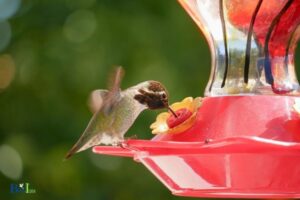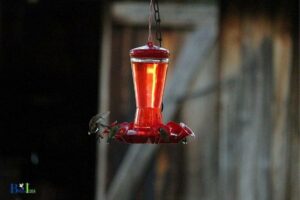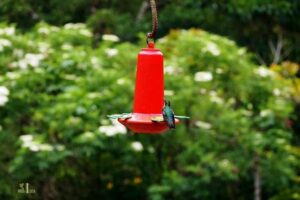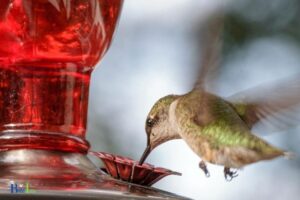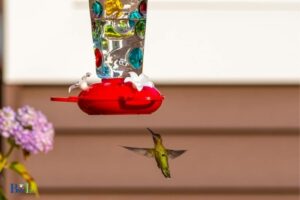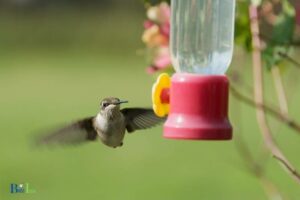How Long Do Hummingbirds Feed: 5-8 Minutes
Hummingbirds feed for about 5-8 minutes per hour during the day.
Hummingbirds have an extremely high metabolism, which requires them to consume large amounts of nectar and insects to fuel their energy needs. In order to meet these demands, they feed frequently and in short bursts throughout the day.
Their feeding frequency is essential to maintain their high metabolic rate and to store enough energy to sustain them through the night or during migration.
Additionally, these tiny birds have the unique ability to enter a state called torpor, which allows them to conserve energy by slowing down their metabolic processes while they rest.
3 Feeding Frequency With Duration for Hummingbirds:
| Feeding Frequency | Duration of Each Feeding | Time of Day |
| Every 10-15 minutes | 30-60 seconds | Daytime (dawn to dusk) |
| Less frequent feeding | 1-2 minutes | Early morning and late evening |
| Lower frequency | 2-5 minutes | Nighttime (rare and specific species) |
Key Takeaway
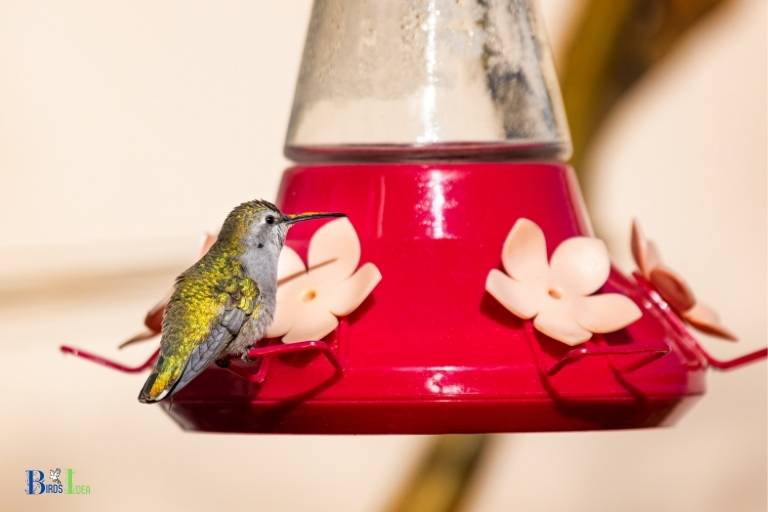
Five Facts About: How Long Do Hummingbirds Feed
The Fascinating World Of Hummingbirds
Hummingbirds are fascinating creatures that are known for their unique ability of hovering in mid-air.
These tiny birds have impressive flying skills that allow them to move forwards, backward, and even upside-down. We’ll dive deeper into the world of hummingbirds, exploring what makes them unique and how long they feed.
What Makes Hummingbirds Unique?
Hummingbirds are known as the smallest birds in the world and have a significant number of unique characteristics that set them apart from other birds.
Here are some key points to consider:
- Hummingbirds are the only species of birds that can fly backward and upside-down.
- They have incredible flying skills with an average speed of 25-30mph, and some species can reach up to 60mph.
- Hummingbirds are amazing pollinators, helping to fertilize different types of flowers and plants.
- These delicate creatures have a high metabolism, and their heart can beat up to 1,200 times per minute.
- Hummingbirds have a unique feeding method, using their long beaks to sip nectar from flowers and feeders.
How Long Do Hummingbirds Feed?
Hummingbirds are known to have a high metabolism, and they require a lot of energy to sustain their daily activities. As a result, these tiny birds need to feed frequently to meet their nutritional needs.
Here are some essential points to consider:
- Hummingbirds feed every 10-15 minutes throughout the day.
- They feed for approximately 30-60 seconds each time.
- During the feeding process, hummingbirds can consume up to twice their body weight.
Hummingbirds are fascinating creatures that continue to amaze bird lovers all over the world. With their unique characteristics and impressive flying skills, they remain an essential part of our ecosystem by helping to pollinate different types of plants and flowers.
Considering how frequently they feed, it’s essential to provide them with a reliable food source, such as a feeder.
So, next time you spot a hummingbird, remember how fascinating they are and what they bring to our environment.
Hummingbird Feeding Basics
Hummingbirds are fascinating creatures that are admired for their agility, beauty, and unique abilities. Have you ever wondered how long these birds feed?
In this blog post, we will explore hummingbird feeding basics, including their anatomy, diet, and foraging habits.
Anatomy Of Hummingbird Feeding Mechanisms
Hummingbirds have some of the most specialized feeding mechanisms in the animal kingdom.
Here are a few key points to help you understand hummingbird feeding anatomy:
- Hummingbirds have long, needle-like beaks that are specially designed to fit into tubular flowers.
- Their tongues can extend up to twice the length of their beaks, allowing them to reach deep into flowers and extract nectar.
- Hummingbirds’ tongues are forked and have grooves that help them lap up nectar.
- They have a unique ability to move their tongues in and out of their beaks, producing a humming sound that is characteristic of these birds.
What Hummingbirds Eat And Drink
Hummingbirds have a demanding diet that mainly consists of nectar and small insects.
Here are a few key points to help you understand their diet:
- Their diet primarily consists of nectar, which provides them with the energy they need to fly at such high speeds.
- To supplement their diet, hummingbirds also eat small insects, such as gnats, spiders, and ants.
- Hummingbirds can consume up to twice their weight in nectar and insects daily.
- They prefer flowers that have a high sugar concentration and are brightly colored.
How Hummingbirds Find Food
Hummingbirds have excellent vision that allows them to spot brightly colored flowers, which are their preferred food source.
Here are a few key points to help you understand their foraging habits:
- Hummingbirds have a remarkable ability to hover in mid-air, allowing them to feed on nectar from flowers while remaining airborne.
- They have a keen sense of smell that helps them find flowers rich in nectar.
- To conserve energy, hummingbirds will select the most efficient route to their food source, often flying in a straight line.
- Hummingbirds will also defend their territory to ensure they have a steady supply of food available.
Hummingbirds have a unique feeding mechanism that allows them to consume nutrient-rich nectar and small insects to sustain their energy needs.
Understanding hummingbird feeding basics, including their anatomy, diet, and foraging habits, can give you a greater appreciation for these fascinating creatures.
The Duration Of Hummingbird Feeding
Hummingbirds are fascinating creatures that have intrigued people for centuries due to their unique characteristics.
These birds are known for their rapid wing beats and exceptional flying ability, which allow them to feed while hovering in the air.
In this post, we’ll explore the duration of hummingbird feeding, including the average feeding time, variations between species, and factors that can impact the length of feeding time.
Average Feeding Time For Hummingbirds
Hummingbirds are incredibly efficient when it comes to feeding. Despite their small size, they can consume nectar that’s equivalent to a quarter of their body weight in a day.
The average time a hummingbird spends feeding varies between species, but it typically ranges from 30 seconds to one minute.
During this time, their long, slender beaks probe into flowers for nectar or small insects to eat. After they finish feeding, they fly away, only to return after several minutes to continue the cycle.
Bullet points:
- Hummingbirds can eat up to one and a half times their body weight in a day.
- Their feeding time ranges from 30 seconds to one minute.
- After feeding, they fly away to rest, then return after several minutes to feed again.
How Feeding Behavior Varies Between Species
Hummingbirds come in various species, and each has different feeding behaviors. For example, the sword-billed hummingbird feeds primarily on nectar from flowers with long beaks that match the length of the bird’s bill.
The long-tailed sylph, on the other hand, feeds on tiny insects found on plant stems and leaves.
Despite these variations, all hummingbirds use their beaks to drink nectar from flowers and feed on small insects.
Bullet points:
- Sword-billed hummingbirds feed on flowers with long beaks, while long-tailed sylphs feed on insects.
- Despite these differences, all hummingbirds drink nectar and feed on insects using their beaks.
Factors That Affect The Length Of Feeding Time
Several factors can impact the length of hummingbirds’ feeding time, including the availability of food, competition for resources, and the bird’s metabolic rate. Hummingbirds need to consume nectar frequently because of their high metabolism.
Hence, the primary factor that affects feeding time is the availability of sufficient food.
If there is plenty of nectar in a given area, it reduces the competition between birds. In contrast, a scarcity of food can cause birds to fight over the available resources, leading to shorter feeding times.
Bullet points:
- The availability of food is the most significant factor that affects feeding time.
- If there’s plenty of nectar available, hummingbirds can feed for a longer time.
- Competition for resources can reduce feeding times.
- Hummingbirds have high metabolic rates and need to feed frequently.
Understanding the duration of hummingbird feeding is essential for any bird enthusiast. Although the average feeding time for hummingbirds varies between species, these birds are incredibly efficient when it comes to consuming food.
By knowing the factors that influence feeding time, you can attract more hummingbirds and create a thriving environment for these beautiful birds.
Maximizing The Time Hummingbirds Spend Feeding
Hummingbirds are remarkable creatures that bring pleasure to the sight of many birdwatchers.
These amazing little creatures have incredibly active metabolisms and flap their wings up to 80 times per second, needing to feed almost constantly.
Tips For Attracting Hummingbirds To Your Garden
Attracting hummingbirds to your garden can seem challenging, but it is incredibly rewarding once you have lured them in.
Here are some tips to help attract these beautiful birds to your garden:
- Planting brightly colored flowers and providing their nectar is the best way to attract hummingbirds. Red, pink, and orange flowers are their favorites, as they contain higher levels of the nectar hummingbirds crave.
- Hummingbirds will frequently visit feeders, which can be purchased, or made at home by combining sugar and water in a 4: 1 ratio. Make sure to change out the water and clean out the feeder at least every few days.
- Exposing open water sources, such as bird baths or fountains, is also a great way to attract hummingbirds to your garden.
Providing Adequate Food Sources
Since hummingbirds burn so many calories, it is crucial to provide them adequate food sources to keep them coming back to your garden.
Here are some tips:
- Always make sure that the bird’s nectar supply won’t run empty, and replenish it regularly, preferable every few days.
- Hummingbirds adore insects and spiders as part of their natural diet. So make sure you don’t use insecticides in your garden.
- You can also provide protein supplements in the hummingbird’s diet through ground-up spiders, fruits, and small insects.
Creating A Safe And Enticing Feeding Environment
While there is no need to sanitize a feeder every time you replenish it with nectar, make sure to clean it out thoroughly at least once a week.
Here are some things to keep in mind:
- Keeping your feeders out of the wind will help prevent nectar from spoiling too quickly.
- It’s crucial to keep your feeders in the shade. Direct sunlight may cause the nectar to spoil at a faster rate.
- To prevent ants or spiders from making their way to your feeder, coat the hooks or chains keeping them in place with petroleum jelly.
When it comes to viewing hummingbirds, maximizing the time they spend feeding is the key to enjoying their beauty. By planting colorful flowers, providing adequate food sources, and creating a safe feeding environment, you can enjoy these beautiful creatures in your garden.
Observing And Learning From Hummingbirds
Hummingbirds are one of the most fascinating birds to watch. They are a delight to observe and learn from. Here are some ways you can make the most of your time studying these amazing creatures.
Recording Hummingbird Feeding Behavior
If you want to observe hummingbirds, one of the best places to start is to record their feeding behavior. By observing this behavior, you can learn a lot about their habits and preferences.
Here are some ways you can go about recording their feeding behavior:
- Use a hummingbird feeder: You can set up a hummingbird feeder in your backyard to attract these birds. Once they start feeding from it, you can observe their behavior.
- Use a camera: You can use a camera to capture their movements while they feed. This way, you can capture their behavior without disturbing them.
- Take notes: You can also take notes of their feeding behavior. Note down the time of day they visit, how long they stay, and what they like to feed on.
Understanding Hummingbird Migration Patterns
Hummingbirds are migratory birds that travel long distances every year. Understanding their migration patterns can help you appreciate their life cycle and how to support them throughout the year.
Here are some key points to keep in mind:
- Seasonal migration: Hummingbirds migrate from their breeding grounds in north america to their wintering grounds in central and south america.
- Timing: The timing of their migration is based on the change in daylight hours. As the days get shorter, they start their migration.
- Flight patterns: Hummingbirds can fly non-stop for up to 18-20 hours. They tend to follow established routes where they can refuel and rest.
How To Support Hummingbirds Throughout The Year
Hummingbirds require favorable conditions throughout the year to survive and thrive.
Here are some tips on how you can support these birds:
- Plant native flowers: Hummingbirds rely on nectar from flowers for their energy needs. You can plant native flowers like salvia, columbine, and bee balm to attract them to your garden.
- Provide a source of water: Hummingbirds need a source of water for drinking and bathing. You can set up a bird bath or a fountain in your backyard.
- Keep your feeders clean: If you use a hummingbird feeder, make sure you clean it regularly to prevent the growth of mold and bacteria. Change the nectar solution every few days to keep it fresh.
By observing and learning from hummingbirds, you can gain a deeper appreciation of these amazing birds. Follow these tips to create a hummingbird-friendly environment in your backyard.
FAQ For How Long Do Hummingbirds Feed
How Long Do Hummingbirds Feed In One Sitting?
How Often Do Hummingbirds Feed?
Do Hummingbirds Feed During The Night?
How Much Nectar Can A Hummingbird Consume?
Conclusion
Hummingbirds are fascinating creatures that require constant energy to maintain their speedy lifestyle.
Therefore, they feed frequently throughout the day, taking short breaks in between. The amount of time they spend feeding depends on factors such as the type of nectar, availability of food, and environmental factors.
Studies have shown that the average feeding time for a hummingbird is between 30 to 60 seconds.
However, their feeding patterns may vary depending on individual preferences. As mentioned earlier, these birds do take a break between feeds to rest and conserve their energy.
It’s also important to note that knowing the right time to refill your hummingbird feeder can make all the difference in attracting hummingbirds to your garden. Ultimately, it is a joy to watch hummingbirds feed and observe their unique behavior patterns.

